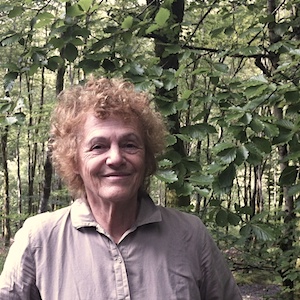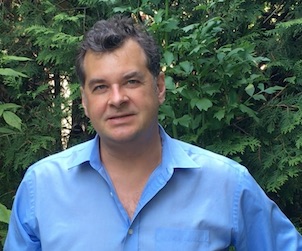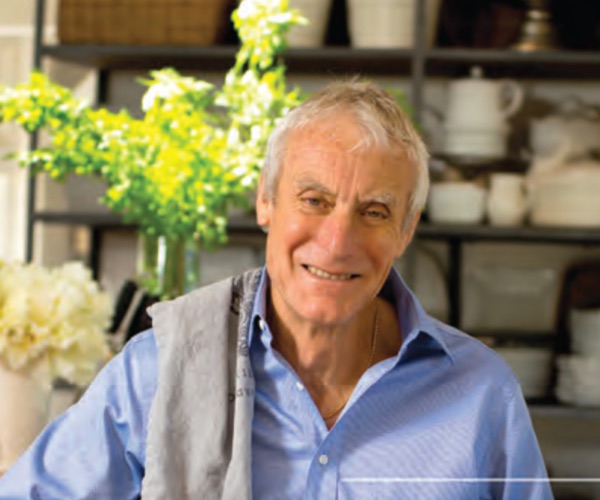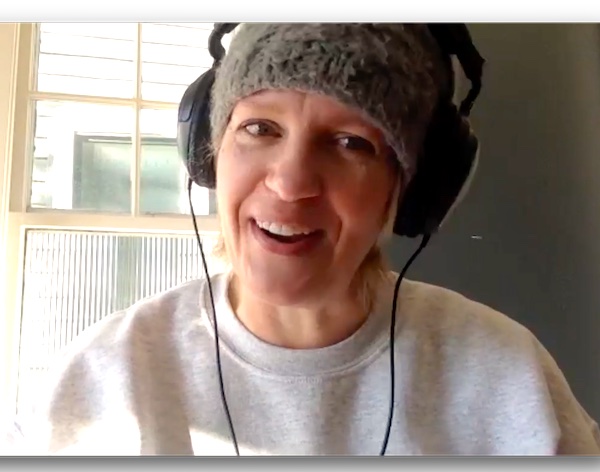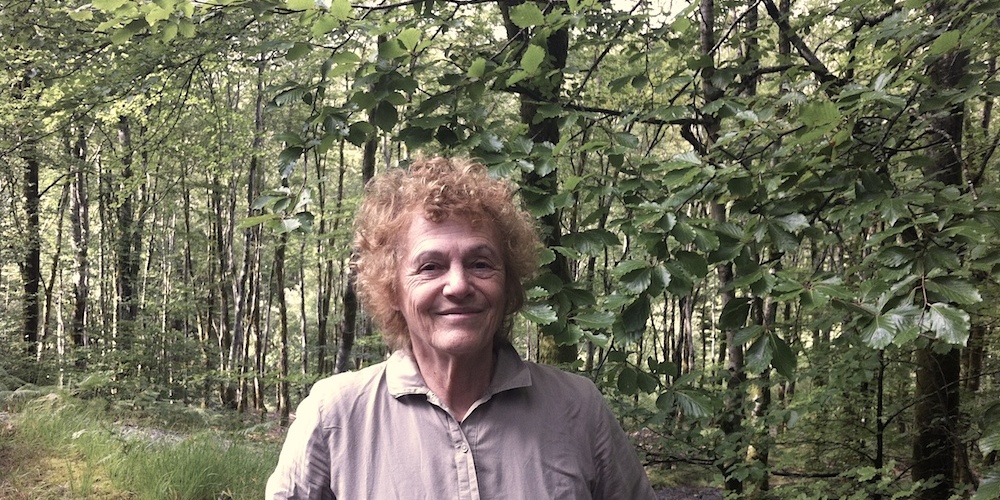
Elisabeth Luard foraging by the Ystwyth River near her house, Brynmerheryn in Wales.
Brynmerheryn means house on the hill of the ram in Welsh Gaelic, and it is the house in Ceredigion (or Cardigan) County where the food writer, memoirist and painter Elisabeth Luard has lived for two decades. She and her late husband, the novelist Nicholas Luard, inherited the house in 1990 from his aunt, Monica Rawlins. Rawlins was an artist and a friend of the painter Augustus John, and the house is filled with art and keeps a Bohemian spirit that impressed my wife Apple and I when we visited Elisabeth there recently. The house is painted a bright pink and sprawls between medieval parts and more recent editions from the 18th, 19th and 20th centuries, including an old very high roofed stone barn that acts as a study and library, with a two story high stack of shelves of cookbooks. Brynmerheryn is indeed on a hill and overlooks a wide valley that rises up again into a range of the Cambrian Mountains. On the other side of the house is woodland populated by young looking birch trees, and there is also a large pond and, of course, a big garden. There is another garden off the kitchen and a passageway covered in glass that acts as a kind of greenhouse, whose inhabitants include a large vine from which bunches of Chardonnay grapes hang. This is a cook’s and a writer’s house, and Brynmerheryn is also the subject of Elisabeth’s most recent book A Cook’s Year in a Welsh Farmhouse.
 Apple and I had come west by northwest to Brynmerheryn for lunch from her father and step-mother’s house near Builth. We holiday there every summer with our kids. I mentioned this to Elisabeth when I conducted her GFR Interview by phone last fall, and procured an invitation to meet in person. I brought Apple along as my navigator, since my experience of driving on the left side of the road is slight and requires more concentration than I can spare paying attention to things like road signs – never mind maps. It turns out my anxieties about driving on the left side would be allayed somewhat by the bulk of the journey on the mountain road between the hamlet of Beulah and the village of Tregaron, since it’s a single track. The etiquette on single track roads in Wales is the downhill vehicle (and trust me, there is always a hill) must back-up until there’s a place to pull over. This creates its own special kind of driver terror as one negotiates in reverse between a sheer cliff one side and the jagged wall of rock outcroppings on the other. After a slow journey over the mountains, dodging the occasional errant sheep, our arrival was delayed by a good hour of getting and remaining lost in the hills around Ystrad Meurig. Finally a kindly postman, for whom I had to reverse on a single track road enwalled by 10 foot hedgerows, gave us foolproof directions to the house, and we arrived a little bit rattled and and very much primed for Elisabeth’s hospitality.
Apple and I had come west by northwest to Brynmerheryn for lunch from her father and step-mother’s house near Builth. We holiday there every summer with our kids. I mentioned this to Elisabeth when I conducted her GFR Interview by phone last fall, and procured an invitation to meet in person. I brought Apple along as my navigator, since my experience of driving on the left side of the road is slight and requires more concentration than I can spare paying attention to things like road signs – never mind maps. It turns out my anxieties about driving on the left side would be allayed somewhat by the bulk of the journey on the mountain road between the hamlet of Beulah and the village of Tregaron, since it’s a single track. The etiquette on single track roads in Wales is the downhill vehicle (and trust me, there is always a hill) must back-up until there’s a place to pull over. This creates its own special kind of driver terror as one negotiates in reverse between a sheer cliff one side and the jagged wall of rock outcroppings on the other. After a slow journey over the mountains, dodging the occasional errant sheep, our arrival was delayed by a good hour of getting and remaining lost in the hills around Ystrad Meurig. Finally a kindly postman, for whom I had to reverse on a single track road enwalled by 10 foot hedgerows, gave us foolproof directions to the house, and we arrived a little bit rattled and and very much primed for Elisabeth’s hospitality.
Elisabeth Luard has had celebrated life in letters in Great Britain. She began her career as the researcher (and sex scene writer, she confessed) for her husband’s books. Then, she started writing in her own right as what the Brits call a cookery writer of not just cookbooks, but also newspaper and magazine articles. Recently she’s become known for her series of memoirs, three having been published and a fourth being written. A Cook’s Year in a Welsh Farmhouse is a sort of hybrid of the two genres. Each chapter covers a month of recipes and is introduced with a pages long description of what happens at Brynmerheryn at that time of year. The book also reveals slowly the history of the house and the people who live near it, as well as as snippets of Elisabeth’s own life, especially on the occasions of visits from her grandchildren. It’s beautifully, gently and often humorously written. The chapter introductions would make fine, if slender, book on their own.
As Elisabeth likes to say, she raised her children in Spain and France. Her husband’s vocation meant they could live anywhere, and they choose those Mediterranean countries, then the island of Mull in Scotland before settling down in Wales. As a young mother, Elisabeth learned the secrets of the Southern European cuisine from her women neighbours. That knowledge formed the foundation of her first (and I would argue most important) book, European Peasant Cookery. The North American title was changed to, and remains, ‘The Old World Kitchen’, which is too bad because it’s Elisabeth’s dedication and admiration for peasant ways that drives this survey of European cuisine. She researched and wrote it 30 years ago when that many more people ate from their gardens and what was grown or raised nearby. Now, recently reissued, it’s as useful, and interesting as ever – perhaps more.
On that word, Elisabeth defines peasantry positively, linking it to the ethos of the small holding farmer: a profound respect for the land and a tendency for innovation and working with what one has. Growing up as the step-daughter of a diplomat, Elisabeth decided the foods her family’s servants ate were better than what they served in the dining room, and she’s stuck to that belief. Her interest is in, as she puts it, “the cuisine of the field, not the town or the hall.”
So, if Elisabeth Luard made the beginning of her food writing career by studying and learning from Europe’s peasants, then A Cook’s Year in a Welsh Farmhouse is the product of another phase in her life. The book, I think, documents her transition into a peasant over two or so decades living at Brynmerheryn. At lunch we discuss that the English language is the one that uses its word for a small holding farmer pejoratively. Paysanne in French does not hold the same negative connotation as its corresponding anglophone word. Even so, when I say to her that I think she has become a peasant, I can’t help blurting out a quasi-apology right after with something like, “I mean no offense!” What I mean by calling her a peasant is that Elisabeth has incorporated the rhythms of her place through the seasons to come up with a collection of simple, but knowledgeable recipes. While the dishes in A Cook’s Year draw heavily on Welsh favourites (there is cawl soup, rarebit, and Welsh cakes), it draws equally on its author’s history of living abroad and present of living in the 21st century. As much as she likes to grow and forage her own food and patronize her local farmers’ market, she is very happy to admit that she also shops at the supermarket like everyone else. She may have been a locavore pioneer before the word existed, but she’s fine with a glug of Spanish olive oil, or a glass of wine from France.
Our lunch was very much in the spirit of A Cook’s Year in a Welsh Farmhouse, though not actually from any recipes from the book. Elisabeth was testing some new things, so we were to be Guineau pigs, and happy for it. We were served freshly baked bread with poppy seeds squeezed from the dried pistils of her own flowers and a ‘cawl’ soup made principally from azuki beans – the small brown Japanese ones. Both being experiments Apple and I thought were delicious, but may evolve yet. With them was a salad of just picked lettuces from the garden, brightened up with a scattering of flowers. Dessert was a peach from the supermarket and a small cup of strong black coffee to counter the effect of the glass of white wine we’d all had. It did the trick of calming me from the terrors of the Tregaron mountain road.
After lunch much conversation and a tour of the house and grounds of Brynmerheryn. The conversation went back and forth, about writing, using the internet (especially in her role as a director of the Oxford Symposium on Food and Cookery), the value of real research (i.e. that includes reading books), and the importance of curiosity to a writer. Perhaps that last point is what separates Elisabeth Luard from so many compilers of recipes and make both European Peasant Cookery and A Cook’s Year so interesting. Elisabeth learns and shares the story before she gives you the dish.
We also spoke a bit of her other career as a painter; she illustrated most of her books and posts her water colours on Twitter and the online food magazine Zester Daily. Soon it was time to go, and Elisabeth insisted on driving us out and pointing us to a much gentler mountain road that started near the Ystwyth River. Before giving us our final wave goodbye, we pulled over in a thicket of woods and foraged for blueberries. The pickings were slim, but she was optimistic there might be another harvest before the end of the summer, and we were grateful for one last small culinary adventure that day.
 Malcolm Jolley is a founding editor of Good Food Revolution and Executive Director of Good Food Media, the company that publishes it. Follow him on Twitter or Facebook
Malcolm Jolley is a founding editor of Good Food Revolution and Executive Director of Good Food Media, the company that publishes it. Follow him on Twitter or Facebook
.

